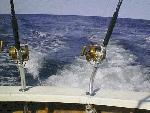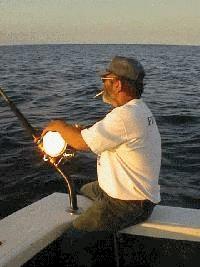The Big Catch
 July 12, 1998, On the Lorrainne B., eighteen miles off the Massachusetts coast. -
Captain Bob Briggs likes big fish - he loves big fish. He loves big boats and the big, blue ocean. He loves to sit on that ocean and hunt the fish, chase the fish, hook the great, silver creature and wrest with it. He so loves to chase and pull and gaff and haul the Atlantic Bluefin Tuna into his boat, that he will do absolutely none of this, while trying like hell, for fifteen hours each day - for weeks sometimes - with the hope that he can do this just once.
July 12, 1998, On the Lorrainne B., eighteen miles off the Massachusetts coast. -
Captain Bob Briggs likes big fish - he loves big fish. He loves big boats and the big, blue ocean. He loves to sit on that ocean and hunt the fish, chase the fish, hook the great, silver creature and wrest with it. He so loves to chase and pull and gaff and haul the Atlantic Bluefin Tuna into his boat, that he will do absolutely none of this, while trying like hell, for fifteen hours each day - for weeks sometimes - with the hope that he can do this just once.
Captain Briggs is a gambler. Like the ten thousand commercial tuna fishermen on the eastern seaboard, he goes for the big game, the few and far between. Last year he only caught nine of these trophies, weighing a total of nearly four-thousand pounds, and that was not a bad year. In fact, catching even one fish put him in the top ten percent of the commercial fishermen, and catching more than one put him in the top one percent. This year, nearly three million pounds of Atlantic Bluefin Tuna will be hauled onto commercial boats on the east coast. Most of it will land on boats off of Massachusetts, as the waters off this southern New England state are the tuna's favorite feeding area. This according to Pat Scida, of the National Marine Fisheries Service, in Gloucester, Massachusetts. But 1997 was not a great year for Captain Briggs and you can blame it on the fish. "They're getting smarter," the captain (and any veteran fisherman) will tell you. Perhaps more believable would be the Darwinian approach that all the dumb fish have already been hooked, beheaded and sliced into sushi. If this were true, it would be not be completely unfair, as the fishermen are certainly getting smarter. Captain Briggs has been fishing for a living for nearly a decade and has fished for tuna since 1966. He has learned where they swim, where they feed and when they feed. He has learned so much about this fish that, if he had to, he could become one himself.
Setting the bobber.
Part I: Finding The Great One
But that only helps him if he has, essentially, already found the fish. To help in the search, his Loran C gear divides the ocean up into a matrix of coordinates, like city blocks. With this device, he can go to the same location - within one hundred-twenty feet - time after time. Today we return to a place he calls "Site 57" where he caught seven out of nine tuna fish last year. The captain would not mind my telling you exactly where Site 57 is, just as he wouldn't mind towing my body back to the dock, a treble hook lodged in my upper pallette.
Surface radar helps Briggs navigate and stay away from other boats, but the two most important tools he uses are the marine radio and the cellular phone. With these he can hear reports from other fishermen and can go to the places where the tuna are biting. The marine radio is too public sometimes, so he gets his good leads off the cell phone.
Part II: Hooking The Great One
We chum with a method called "chunkin'" where we sit anchored in two hundred feet of water. We (I) stand for hours with a fillet knife and slice ten-inch herring into four or five chunks, dropping one chunk every ten seconds over the side. After a few hours of cutting fish guts and teasing my inner ear with two-foot swells, I start getting nauseated. I know that looking at the horizon will cause certain gastric upheaval so I keep my gaze downward toward the smelly, slimy fish guts.
After I drop each chunk over the side, the current pulls it past the stern and toward our waiting, baited hooks. We have four baits set behind the boat, at graduating depths to one-hundred feet, and the chunks, as they float back and sink lower, pass by our bait. The tuna will eat a chunk or two and then will chomp hard on our bait, catching that nasty hook in his mouth and sending us into part three in less than one second.
I am to then cut the anchor line above the bouy - the hell with untying it - then I have to get busy. As Captain Briggs works the motor, chasing the prey forward, backward or sideways, I am to reel like mad and listen to every word he says. Things will get nasty here and I am not to take things personally - just do everything he tells me to. Any mistake and we will lose the fish, and the reason the good captain spends weeks and weeks out here before a getting a strike is to not lose the goddamn fish. I will reel and pull and pull and reel, perhaps for an hour or longer. And if my arm falls right off and I pass out on the deck from exhaustion, the order is clear; I am to keep reeling.
But I will not pass out, as I will be running on adrenalin, fighting a beast two or three times my weight and that hour will fly past and I will remember that experience for the rest of my life. Captain Briggs calls it "the fifty minute orgasm".
When the giant fish (and we will catch a giant one) is close enough to the boat and is exhausted from the fight we have given it, Briggs will gaff the beast and we will haul it over the side and into our boat and onto our deck. We will have outsmarted the Great One with a formula of trick prey and bait. We will have outmastered the fish with sheer muscle, strategy and finesse. We will have conquered one of man's oldest prey with our own hands and it will be ours and we will practically walk on the water back to the dock.
This fight will occur thousands of times this year as commercial and recreational fishermen alike chase The Great One. It is a real contest every year, a scramble to catch as much fish as possible before the quota for the country is met. The "government" as the fishermen call the National Marine Fisheries Service, has set many guidelines and quotas to regulate the number of fish caught; fishermen can't keep a tuna less than seventy-three inches long (recreational fishermen can only keep fish less than seventy-three inches, but cannot sell them); they can only fish on certain days; they can only catch one tuna per day, and many other confusing regulations. But the toughest rule is that, when the quota is met, they must stop fishing for tuna.
The tuna season starts in June and can last until October and here's the rub; the later in the season, the bigger and better the fish. In June, a fish may weigh three to four hundred pounds and will fetch three to four dollars per pound. As the summer feeding season continues, the fish grow larger and fatter and fat is what the buyers treasure. By September or October, you could have a twelve hundred pound tuna thrashing on your deck and every dressed pound of it will earn you twenty-five to thirty dollars, a fish worth twenty to thirty grand.
Ready for Market
The Japanese, fanatics for exotic foods, love the taste of raw Atlantic Bluefin Tuna and Japan is the main market for this fish. "If I catch a fish here at noon," Briggs says, "it will be in the Japanese market by tomorrow at noon." A very good tuna, or "ichibon" is sliced up paper-thin and served in sushi restaurants for hundreds of dollars per pound. The U.S. market for Bluefin Tuna is very small (tuna we get in a can is a different fish, caught in nets in the Pacific.) "I've never heard of a domestic fish over three bucks," says Briggs.
There is always disagreement between the fishermen and the government about quotas. Fishermen believe that there are plenty of fish, while the government says there aren't. Actually, the fisheries service claims that there is only about thirteen percent of the amount of fish (by weight, or "biomass") that there was in 1975. The quotas are designed not only to stop the reduction in the tuna population, but to increase it. "At current catch levels, the biomass will double in twenty years," says Scida.
The quotas do have a positive effect. Keeping the supply down helps maintain the tuna's status as a somewhat rare delicacy. With higher quotas and fewer restrictions there would be a lot more fish caught and the prices would drop. So, for example, if the catch Captain Briggs brought in last year brought him, say, twenty thousand dollars, then with more fish being sold, he may have only earned ten to fifteen thousand. So he would have to catch a lot more fish to earn the same amount of money.
And the fisheries service believes that, if the quotas are raised, then there will be fewer and fewer fish each year for Captain Briggs to catch. The quotas are actually initiated by ICAT, an international organization that meets in Spain each November to maintain the tuna population worldwide.
At the Reel
I am not a fisherman and that does not automatically mean that I am not a liar, but I have to admit that on our trip we did not catch The Great One. We caught a few sand sharks and I caught a queasy stomach, but nothing to tip the quota.
The general fish population off the coast of Massachusetts has been in a steady decline since the early eighties, claim many fishermen. "Used to be, you could walk across the water on Cod out there," says Darcy Lund, owner of Harbor Marine Bait and Tackle. "But everything has just been overfished. The Russians and Japanese would come in here with vacuum cleaners and floating canneries." The expansion of our waters to two-hundred miles in the early nineties has helped considerably.
Fishing is a dangerous job, especially in the cold, north Atlantic waters. Two men died last year off of Massachusetts. Lund held a fund raiser and the community donated several thousand dollars to the relatives. "Fishing is a tight-knit family," says Briggs. "You've got your bait guys, your fishermen, your buyers..." This could be one of the reasons why he enjoys his career so much, or it could be the fight, or, honestly enough, it could just be the view.
Sunset from the Lorrainne B., Massachusetts Harbor, July 12, 1998
Return to our
|


 Part III: Reeling in The Great One
Part III: Reeling in The Great One



